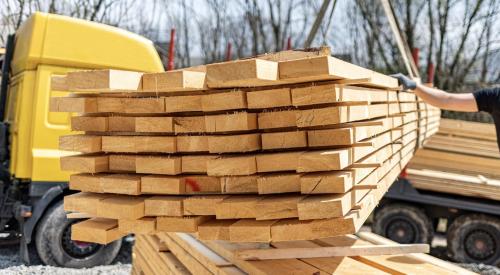The home building industry is overheating and inflation is threatening affordability. To illustrate that dynamic, think of it as a pyramid: the horizontal axis represents the total number of households that can afford a home; the vertical axis represents the home’s sales price; and the bottom of the pyramid—its widest point—represents the U.S. homebuying population if the price of a home were zero (that is, if homes were free). As home prices rise, we climb the pyramid and the further up we go, the smaller and smaller its width becomes—representing the shrinking number of buyers who can afford a new home. In the last 14 months, we’ve gone pretty far up the pyramid.
This truth is creating a housing affordability crisis that will be exceedingly difficult to undo. At the current rate of inflation, an increase in wages or income can’t happen fast enough to mitigate it. (In fact, inflation increases with wage/income growth, so it’s a vicious circle.) The only way to solve an affordability problem once it gets out of hand is to drop prices. But builders can’t drop home prices when their costs to build them are also skyrocketing.
Some builders are already waiting to release lots to sales until after the home is framed or, in some instances, is fully completed. Others are even adding escalation language to the homebuyer’s contract that enables the builder to increase the purchase price as the builder’s costs increase. That tactic isn’t good for the home builder or for the industry.
RELATED
- 5 Tips for Dealing With 'Take It or Leave It' Ultimatums When Negotiating
- Next-Gen Hiring Practices for Home Builders
- Rethinking the Global Supply Chain
- What’s Your Ratio? Purchasing Ratio, That Is
Home Building Costs Are Climbing. Can We Get Them Under Control?
For those who subscribe to my YouTube channel, you know I’ve been concerned for some time about inflation and the impact it can have on home building. But just how bad is inflation? At the time of this writing, framing lumber is up 84.8% in the last 12 months, OSB is up 349% and still climbing, and other commodities are up as well. According to ProPurchaser.com, which tracks and reports on supplier raw material costs, cold-rolled steel is up 193%, hot-dipped galvanized is up 167%, copper 59%, ABS 109%, and aluminum 57%, while diesel is up 81% and natural gas is up 133%—all in the last 12 months. At the same time, the U.S. dollar’s purchasing power is down 8%. Given the volume of products the U.S. imports, that adds to inflation woes; not to mention the transportation challenges associated with a global container shortage caused by backed up ports and increased demand.
You know how painful it is to get costs back in line once they’re out of control. As an industry, we must work together to contain costs before it’s too late.
If you’ve been in the industry awhile, you’ll likely remember the last housing cycle. Specifically, you know how painful it is to get costs back in line once they’re out of control. As an industry, we must work together to contain costs before it’s too late. Here are some considerations from a cost-containment perspective.
Construction Cost Drivers and Fair Play
First, when you’re faced with yet another cost increase for a material, system, or for labor, identify the cost drivers prompting the increase, then tie the increase to an index. That way, when the index goes down, you can return to the previous cost of the product or service.
It’s also essential that you do your homework. The old adage “Trust but verify” applies here. If you agreed to a higher labor cost, ask workers on the jobsite if they saw a bump in their pay. You also can verify higher costs from a supplier or trade by checking with other manufacturers, distributors, and installing trades; just ask for copies of the supplier’s materials invoices that show costs increasing. If the increase is legitimate, the supplier’s invoices will confirm it ... and you should do all you can to keep them whole, net of the increase. It doesn’t do any good if your partners are losing money.
However, if they’re not willing to show you invoices, it’s likely they’re marking up and profiting from the increase. Be sure to remember those that treated you fairly during the good times, as well as those that didn’t, because the market won’t always be this strong. When the market turns, you’ll want to continue relationships with those companies that worked fairly with you.
Labor Needs for the Housing Industry
What about the labor shortage? Every manufacturer I know (and I know most that supply the home building industry) is hiring. And positions remain open, or a new one opens as soon as an existing position is filled. With all of these open jobs, how is it that unemployment is 6.1%? Employers are even raising hourly rates and offering hiring bonuses and additional benefits to attract applicants. Unfortunately, this doesn’t seem to be helping, as one manufacturer pulls workers from another, rather than from the pool of unemployed.
That’s yet another driver of inflation. At some point, the Fed will need to raise interest rates to curb all of this inflation, which will further cripple affordability.
Ways Home Builders Can Keep Inflation in Check
So, what can we do to help keep inflation in check? Builders should work with suppliers and installers to gain efficiencies and keep costs down as much as possible.
If you are a supplier or installing trade, rather than just presenting a price increase to a builder, offer them solutions and recommendations to help offset that cost increase. For example, with order backlogs as strong as they are now, ask the builder to even-flow production for greater efficiency.
And builders, you should do all you can to be as consistent and predictable as possible throughout the construction process. Also, work to improve communication with your suppliers and trades. Eliminate last-minute change orders. With the market this strong, do you really need to allow homebuyers to make changes after the cutoff?
Materials shortages are another issue plaguing our industry, increasing cycle times and decreasing buyer satisfaction. Some of the more significant shortages have included appliances, circuit breakers, door hardware, fiberglass entry doors, garage doors and openers, windows, Romex wire, PEX pipe fittings, HVAC equipment, paint, engineered wood products, cultured stone, housewrap, siding, and sinks ... and that’s the short list. Talk with manufacturers and you’ll learn that the reasons for the shortages vary and may include sales exceeding capacity, the Texas freeze, raw materials shortages, import delays, and labor shortages, among other things.
What can home builders do to help? Give suppliers and installers extended lead times. And ask that they do the same for their suppliers and so on, all the way up the supply chain.
Also, if you’re an installer, stop assuming materials will just show up as planned. Follow up with suppliers to make sure deliveries will arrive when scheduled. Ask suppliers to give advance notice of any back-orders. Time is the single most significant factor we all have to address amidst a materials shortage. Perhaps you can get the material from another distributor or from a different market. Or maybe the builder will approve an alternative product.
I expect things will get worse before they get better, but they will get better. The fourth quarter is always a struggle, as builders on a calendar year push volume before year-end. I know builders that close as many homes in Q4 as they do during the first and second quarters combined. We can get through this by working together. The more we keep costs down and construction flowing, the better off we’ll be as an industry.













